1.1 Functions of Sports Events Management
1.1.1 Planning in Sports
It is an intellectual process of thinking in advance about setting of goals and developing strategies which are required to attain the goal efficiently in the field of sports. Deciding the future course of action and developing strategies to attain the goals efficiently in the field of sports. Importance of planning in sports : (i) Planning is crucial for the seamless, efficient and conflict-free operation of sports and sporting events. (ii) A clear definition of the aims, objectives, and goals is necessary for effective planning of sports events. (iii) It should also define the strategy or method for achieving the goal in simple and understandable language. (iv) A professional sports plan should be created, integrating the elements of commitment, enjoyment, and voluntary effort. Objective of planning in sports : (a) Enhance creativity (b) Increase efficiency (c) Reduce chances of mistake (d) Facilitates coordination to complete the task in given time period (e) Achieving the pre-determined targets in given budget.
1.1.2 Organising
Organising is the management function of assigning duties, grouping task, organising personnel and allocating resources to carry after specific plan created during planning. Importance of organizing in sport events : (i) To achieve the goals established during the planning stage, resources must be allocated and personnel must be organised. (ii) The types of jobs and responsibilities required to achieve planning objectives are determined during the organising stage. (iii) An organisational chart with examples of the various positions and reporting structures should be created at this stage.
1.1.3 Staffing
Staffing refers to the process of hiring eligible candidate for suitable designation/position to achieve the aims and objectives of an organization. It is finding right person for right position. Importance of staffing : (i) During this process, qualified employees are recruited and selected. (ii) This stage includes orientation, training, and professional development after hiring personnel. (iii) During orientation, new employees are introduced to the nature, goals, and policies of events in order to keep them focused on the organization’s goals. (iv) At this stage, various training programmes are held to provide professional training to the staff. Staff should be recruited for sporting events based on the needs of the organisation. For example, the highest position could be Director of the event, followed by Deputy Director and then Assistant Director of Sports Event may be created.
1.1.4 Directing
The process of supervising, encouraging, guiding, and communicating with subordinates in order to achieve the organisational goal is known as directing. Importance of directing : (i) Directing personnel is a leadership quality that includes informing employees about what needs to be done, by whom, and when. (ii) It entails supervising personnel while also motivating them. (iii) Planning and organising have no meaning unless personnel are directed. (iv) It is the function of guiding, inspiring, and instructing others in order to achieve organisational goals.
1.1.5 Controlling
The processes that leaders develop to monitor success are referred to as controlling. Establishing performance standards, measuring actual performance, and comparing it for irregularities are all part of the controlling process. Importance of Controlling : (i) Controlling is an important management function because it involves giving employees instructions and ensuring that those instructions are followed. (ii) In order for a sports event to be successful, instructions given to members of the organising committee towards achieving a common goal, that is organising a sports event, must be carried out sincerely. (iii) Higher-level management oversees lower-level employees to ensure that resources are used efficiently and effectively.
1.2 Formation of Committees
Committee is a group of people appointed or elected to administer, discuss, perform a specified service function or make reports concerning a subject on which its members are authorities. Committees should be formed based on three levels of management: top, middle, and lower. Suitable people are chosen for various committees based on the level or area of the sporting event. 
 There is no set number of committees that must be formed to organise a sporting event; it is determined by the number of participants, the level of the event, the area of specialisation, the dedication of volunteers, and other factors. We can generally form four committees under an organising committee. Examine the chart below to learn more about their jobs and responsibilities.
There is no set number of committees that must be formed to organise a sporting event; it is determined by the number of participants, the level of the event, the area of specialisation, the dedication of volunteers, and other factors. We can generally form four committees under an organising committee. Examine the chart below to learn more about their jobs and responsibilities.  Chairperson, Organising Committee : The Event Chairperson provides the leadership for the entire event planning process. As the leader, the Chairperson will recruit and motivate committee members and event volunteers and act as the spokesperson for the entire group.The Chairperson will orchestrate the overall production, providing advice when needed and will be prepared to make the final decisions. Organizing Committee assists and advises the event director to formulate plans and policies. Committee members, have a good knowledge of the event management plan, are well placed to provide training, supervision and assistance to other personnel involved.
Chairperson, Organising Committee : The Event Chairperson provides the leadership for the entire event planning process. As the leader, the Chairperson will recruit and motivate committee members and event volunteers and act as the spokesperson for the entire group.The Chairperson will orchestrate the overall production, providing advice when needed and will be prepared to make the final decisions. Organizing Committee assists and advises the event director to formulate plans and policies. Committee members, have a good knowledge of the event management plan, are well placed to provide training, supervision and assistance to other personnel involved.
1.2.1 Technical Committee
Technical committee is in charge of the technical aspects of the events, such as requisitioning sports equipment and running matches on time with the help of selected officials (referees, umpires, judges, timekeepers, and so on) for their respective games/sports. Pre-sports event/tournament : Prior to the event, the Technical Committee is responsible for submitting a requisition to purchase equipment, inviting and receiving confirmation from officials to conduct the sports event, cleaning and laying out of the fields, arranging equipment and stationery, preparing fixtures, and enforcing the rules and regulations of the sports event. During a sporting event/tournament : The Technical Committee is responsible for conducting matches, ensuring the presence of the jury, cleaning and laying out the fields, collecting score sheets and other related papers from officials, preparing the merit list, and so on. Post sports event/ tournament : After the event, the Technical Committee arranges for the cleaning and layout of the fields, field maintenance, and the return of all equipment to storage. Responsibilities of technical committee : (1) To ensure that the field of play is safe for competitors and officials (2) To apply (not interpret) the Rules without fear or favour (3) To ensure the quality and technically of equipments
1.2.2 Logistics Committee
Logistics committee’s responsibilities include everything from transportation, boarding, and lodging to refreshments, decoration, and conducting event ceremonies. As needed, this committee may be divided into sub-committees. The Logistics Committee oversees the Opening Ceremony, hires a photographer/videographer, and plans the Victory and Closing Ceremonies, including refreshment, decoration, reception, entertainment, light and sound, medical aspects, and so on. For big events more sub committees are created : Transportation Committee : They are responsible for the transportation of teams from railway station/ bus station to the place of their accommodation. They transport the teams to the place of competition and back to their place of accommodation. They also take the teams for site seeing. Prize Committee : Is responsible for the purchase and distribution of the medals for the athletes who secure place. Catering and Service Committee : Determines all food and beverage needs, works with the caterer and handles all table seating and service requirements for the event. Decorations Committee : Develops the atmosphere and ambiance for the event by decorating the stadium and the surrounding areas around the stadium. Reception Committee : They are responsible for receiving the competitors and guiding the competitors to different persons responsible for different committees after listening to their query. They are responsible for the reception of guest and other dignitaries who have been invited. Entertainment Committee : Plans the entertainment during the event, dance and display before, during and after the event. Medical Committee : Is responsible for taking care of the athlete’s who had got injured during the event or ill due to any reason like long travel, climate, food, etc. Pre-sports event/tournament : It is the Logistics Committee’s responsibility to oversee the placement/arrangement/purchase of stationery, chairs, tables, souvenirs, light and sound equipment, bouquets, sending invitations to stakeholders including other schools/institutions and VIP guests, requisition of purchase of medals and certificates, arrangement of refreshments, arrangement of boarding and lodging, selection of volunteers, preparation of first aid kit, and so on. During sports event/tournament : The Logistics Committee is in charge of the Opening and Closing Ceremonies, checking registration, distributing refreshments, managing spectators, handing out medals and certificates, and transporting players/participants from their place of stay to the field and back. Post sports event/tournament : The Logistics Committee is in charge of cleaning the venue and relocating the items to their proper locations.
1.2.3 Finance Committee
This committee develops the budget, pay the bills and most importantly, receive the revenues. It is involved in all aspects of the sports event’s finances, such as planning, accounting, decision-making, and so on. The committee’s primary focus is on finalising sponsorship, monitoring the inflow and outflow of funds, purchasing equipment and other items needed to run the event, and settling official payments. It is the foundation of the sporting event. It pitches to various businesses and persuades them to sponsor the event. Pre-sports event/tournament : Prior to the event, it is the Finance Committee’s responsibility to prepare the budget, purchase sports equipment, stationery, medals, certificates, and other requirements as desired by the other committees, as well as prepare and finalise the MoU (Memorandum of Understanding) with sponsors. During a sporting event or tournament : Throughout the event, the Finance Committee monitors the outflow and inflow of funds, including payments and remuneration to officials. Post sports event/tournament : On conclusion of the event the Finance Committee examines all records related to the settlement of bills and accounts and prepares the financial report. Responsibilities of finance committee : (1) Budgeting and financial planning (2) Financial reporting (3) Monitoring of internal controls and accountability policies
1.2.4 Marketing Committee
Marketing committee is responsible to get the best audience possible, and the best sponsorship and support available. Sponsorship committee insures that all supporters of the event are recognized by placing sponsor’s banner or by displaying the product of the sponsor at the arena if possible. The Marketing Committee creates plans and strategies to market the event in order to generate publicity and sponsorships. Publicity can be done through various channels such as social media, print media, TV, e-mail, and so on, and sponsorship can be generated in cash or kind by forming media partners, food partners, drink partners, and so on, by calling on, meeting with various companies, and so on. The Marketing Committee also organises event-related campaigns. Pre-sports event/tournament : The Marketing Committee develops a strategy for arranging sponsorships, publicising the event, arranging meetings or calling on sponsors, preparing sponsorship MoUs, and so on. During sports event/tournament : the Marketing Committee issues press releases, works with the media, manages communication methods, fulfils sponsor requirements per MoUs, arranges for event telecast, and so on. Post sports event/tournament : Once the event is over, the Committee issues a press release and may arrange for a re-telecast of the event. Responsibilities of Marketing committee: (1) Management of budget during the activity (2) Registering all participants with an operational role (3) The production and distribution of the validation pass (4) Assigning the access rights and privileges to which a participant is entitled
1.3 Fixtures and Its Procedures
In sports, an individual generally supports a particular team or player to win the game. There are different types of fixtures in different tournaments based on duration, cost, manpower, level, interest etc.If you’ve ever watched a tournament, you’ve probably seen a player or team lose a game and get knocked out. In other competitions, though, they carry on playing even after they lose. There are different types of fixtures in different tournaments that explained here.
1.3.1 Tournament
It is series of competition between different teams. It helps to decide the positions like first, second and third. For a tournament to take place, there should be minimum two teams. Tournaments may be of different types like knock-out, league, and league-cum-knock-out and challenge.  Knock-out Tournament : In this tournament a player or team have to consistently give their best performance to continue playing matches until it is defeated or elimination. In a knock-out tournament if a team loses a single match, it will be out of the tournament. Only the winners move to the next round of matches. Formulae to find the number of matches in a knock-out tournament is n – 1 where n is the number of teams participating in the tournament. If the number of teams in a knock-out tournament is 17 the Number of matches is 17 – 1 = 16. Advantages of knock-out tournament are :
Knock-out Tournament : In this tournament a player or team have to consistently give their best performance to continue playing matches until it is defeated or elimination. In a knock-out tournament if a team loses a single match, it will be out of the tournament. Only the winners move to the next round of matches. Formulae to find the number of matches in a knock-out tournament is n – 1 where n is the number of teams participating in the tournament. If the number of teams in a knock-out tournament is 17 the Number of matches is 17 – 1 = 16. Advantages of knock-out tournament are :
- It takes less time to finish the tournament. Number of matches in a knock-out tournament is less compared to league tournament.
- It is economical.
- Each match is crucial for each team so each match becomes interesting for spectator.
Disadvantages of knock-out tournament are :
- Luck may help a team to reach finals. Sometimes, all good teams may be in one half and all weak teams in other half and this helps a weak team to reach the finals.
- Good teams may, sometimes, get eliminated in the early stage of the tournament as they may have to compete with another good team in the preliminary rounds.
- If a good team is not performing well in certain match, it will not get second chance to compete if it has lost the match
- There is a lot of pressure on players to perform well because each match is crucial.
- Less number of matches for players to show his talent and also for the selectors to spot the talent.
League Tournament : In a league tournament each team competes with every other participating in the tournament. In League Tournament is also known as Round Robin Tournament.In a league tournament every team participating in the tournament has to compete with every other team. Winners are decided on the basis of the points acquired after all the competitions. For each win a team may be awarded 2 points, draw 1 point and for a loss no point is awarded. Formulae to find the number of matches in a league tournament = n (n – 1)/2. Where n = number teams participating in the tournament. The number of matches in a league tournament of 9 teams= 9 (9 – 1) / 2 = 36 matches. In a single league tournament, every team competes with every other team participating in the tournament once. In a double league tournament, every team competes with every other team participating in the tournament twice. Advantages of league tournament :
- Luck factor does not have a role to play as each team gets to play with all the team.
- If a good team has lost a match, it still can be winner of the tournament because it has other matches to play.
- There is less pressure on players to perform well because each match is not crucial.
- More number of matches for players to show their talent and also for the selectors to spot the talent.
Disadvantages of leaguetournament :
- It takes more time to finish the tournament. Number of matches in a league tournament is more compared to knock-out tournament.
- It is not economical.
- Each match is not crucial. So, some matches may become boring for spectator.
- More time consuming
- Large quantity of resources required
- Facilities for accommodation and mess services required on large scale.
- Moral of the team becomes low due to repeated defeat.
There are two types of round robin tournament : (i) Single league tournament : A tournament in which each team plays each other team once and the number of matches is determined by N(N – 1)/2, where N represents the number of teams participating in the event. For example if 5 teams are competing the total number of matches to be N(N – 1)/2 = 5(5 – 1)/2 = 5 × 2 = 10 matches. (ii) Double league tournament : A tournament in which each team plays every team twice and the number of matches is determined by N(N–1), where N denotes the number of teams participating in the event. For example if 5 teams are competing the total number of matches to be N(N – 1) = 5(5 – 1) = 5 × 4 = 20 matches. Difference : Page 5 MS Q1 Put inside Box “Imp. Points or Exam Cracks” League tournament is a better way to judge the best team of the tournament as : Every team gets maximum opportunity to show its efficiency. Ample number of opportunities is available to the teams/players to improve their performance. Also, the ranking of team can be judged by the maximum number of matches or points won by the team. Combination : Combination tournament are those tournament in which initial round of tournament are played on particular basis (knock-out or league) and rest of the tournament played on another particular basis (Knock-out/League) They are a combination of the Knock-Out and League formats. Combination Tournaments can be Knockout-League, League-Knockout, Knockout-League-Knockout, and so on, depending on the demand and relevance of the competition. Need for Combination of tournaments : (a) When there are a high number of participants (b) When participants are distributed across several areas (c) When venues are located in different zones/locations, and so on. (d) Some of the drawbacks of Knockout and League Tournaments can be avoided under this structure. In a league cum knock-out tournament, competition is conducted in two phases. In the first phase, competition is conducted in the form of a league and through this competition a pre-decided number of teams are selected on the basis of points secured from the top. In the second phase pre-decided number of teams selected from the league matches will participate in a knock-out tournament and from this first and second are decided. In a knock-outcum leaguetournament, competition is conducted in two phases. In the first phase, competition is conducted in the form of a knock-out and through this competition a pre-decided number of teams are selected on the basis of Performance secured from the top. In the second phase pre-decided number of teams selected from the knock-out matches will participate in a league tournament and from this first and second are decided on the basis of the points.
1.3.2 Fixtures, Byes and Seeding
Fixtures—Definitions : The organized method in which teams participate in any tournament is a fixture.
- Fixture means arranging the matches in a tournament with details of venue, date and time.
- Fixture is a procedure to set a sequence of matches for participating teams.
- Fixture is a process of arrangement of the teams in systematic order in various groups for competitive fights in physical activity’.
Byes—Definitions : A Bye in a fixture means that the team which gets a bye is exempted from playing the first round and enters the second round directly. The position of a participant in a tournament who is not paired with an opponent, usually in the first round, and advanced to the next round without playing. The right to proceed to the next round of a competition without contesting the present round, often through nonappearance of an opponent. Reasons when byes are assigned :
- Uneven team distribution in tournament (In a knockout tournament, the number of teams equals the power of two [e.g., 8, 16, 32, 64,….] and in a league tournament, if the number of teams is odd.
- Previous champions are pooled separately in the same group to create an even competition.
- To prevent one team from playing more matches on a single day than the other, putting some at a disadvantage.
Byes are given in the first round by which the number of teams playing in the 2nd round is reduced to power of two. Formula for giving Bye = Next power of 2 – Number of teams Upper Half (UF) = nb + 1/2 Lower Half (LF) = nb – 1/2 Common Error : In simple words : Next power of 2 means {2, 4, 8, 16, 32, 64, etc.} For calculating byes take next power 2 greater than No. of teams. Then, Next power of 2 – No. of teams For Example There are 11 teams participating in a Knock-out Tournament. So, Number of team = 11 No. of Bye = 2n – No. of team = 24 – 11 = 16 – 11 = 5
1.3.3 Procedure to Draw Fixtures Knock-out (Bye and Seeding)*Very important topic for Exam
Step 1 : There is no need for byes if the number of teams is 2, 4, 8, 16, 32, 64, 128, … (Number being a multiple of two). But, if the number of teams are Odd then byes will be given. Step 2 : The following formula will be used to calculate the total number of matches to be played in the tournament. Total Number of Matches = Number of teams – 1 In case of 8 teams then 8 – 1 = 7 matches (not including third place match) If number of teams are 25 (which is odd) then 25 – 1 = 24 matches (not including third place match) Step 3 : The total number of teams are to be divided into two halves, namely Upper Half and Lower Half. If the total number of participating teams are even in numbers the Formula will be :![]() If total number of teams is 14 then, 14/2 = 7, i.e., 7 teams will be placed in Upper Half and the remaining 7 will be placed in Lower Half. If total number of participating teams are odd in numbers then Formula will be
If total number of teams is 14 then, 14/2 = 7, i.e., 7 teams will be placed in Upper Half and the remaining 7 will be placed in Lower Half. If total number of participating teams are odd in numbers then Formula will be  Ex. If total number of teams are 25 then
Ex. If total number of teams are 25 then  So, 13 teams are placed in upper half and 12 teams are placed in lower half Rounds in a tournament : Next higher power of 2 from the number of teams, then the higher power of 2 are the number of Rounds in the tournament. If the number of teams in a tournamentis not equal to higher power of 2, then the number of Rounds is next higher power of 2. For Example : let’s suppose there are 25 teams in a tournament then next higher power = 32 (25), So Number of Rounds = 5. If the number of teams in a tournamentis equal to higher power of 2, then the number of Rounds equals to higher power of 2.For Example: let’s suppose there 8 teams in a tournament which is a higher power of 2 (8 = 23) then Number of Rounds = 3. Step 4 : After determining Upper and Lower Half Teams in Step 3, byes will be allotted. We can find the byes by taking the difference between the number of teams in the Tournament and the next power of 2 of the teams in the Tournament. For Example : If the total number of Teams is 14, the following power of two is 16 (16 = 24), 16 – 14 = 2 Byes In the case of even numbers, byes will be placed in the upper and lower halves = 2/2 = 1 (each) If the total number of Teams is 25, the following power of two is 32 (32 = 25), 32 – 25 = 7 Byes In the case of Odd numbers,
So, 13 teams are placed in upper half and 12 teams are placed in lower half Rounds in a tournament : Next higher power of 2 from the number of teams, then the higher power of 2 are the number of Rounds in the tournament. If the number of teams in a tournamentis not equal to higher power of 2, then the number of Rounds is next higher power of 2. For Example : let’s suppose there are 25 teams in a tournament then next higher power = 32 (25), So Number of Rounds = 5. If the number of teams in a tournamentis equal to higher power of 2, then the number of Rounds equals to higher power of 2.For Example: let’s suppose there 8 teams in a tournament which is a higher power of 2 (8 = 23) then Number of Rounds = 3. Step 4 : After determining Upper and Lower Half Teams in Step 3, byes will be allotted. We can find the byes by taking the difference between the number of teams in the Tournament and the next power of 2 of the teams in the Tournament. For Example : If the total number of Teams is 14, the following power of two is 16 (16 = 24), 16 – 14 = 2 Byes In the case of even numbers, byes will be placed in the upper and lower halves = 2/2 = 1 (each) If the total number of Teams is 25, the following power of two is 32 (32 = 25), 32 – 25 = 7 Byes In the case of Odd numbers,  Step 5 : Allotment of byes in the fixture should be given in following order : First bye will be given to last team of Lower Half, Second bye will be given to first team of Upper Half, Third bye will be given to first team of Lower Half, Fourth bye will be given to last team of Upper Half Same pattern will be followed after fourth bye till the remaining byes have been given. Step 6 : Draw a fixture (i) Write the serial number and the number of participants (teams) in vertical order. (ii) Divide the participants into two halves (Upper Half and Lower Half) as per Step 3. (iii) Now allot byes as per step 5. (iv) Place the remaining teams in a random lottery system from top to bottom, or use the same pattern as for byes.Teams with byes will not participate in the first round. (v) Put the dates, times, and locations in front of the matches in the fixture.
Step 5 : Allotment of byes in the fixture should be given in following order : First bye will be given to last team of Lower Half, Second bye will be given to first team of Upper Half, Third bye will be given to first team of Lower Half, Fourth bye will be given to last team of Upper Half Same pattern will be followed after fourth bye till the remaining byes have been given. Step 6 : Draw a fixture (i) Write the serial number and the number of participants (teams) in vertical order. (ii) Divide the participants into two halves (Upper Half and Lower Half) as per Step 3. (iii) Now allot byes as per step 5. (iv) Place the remaining teams in a random lottery system from top to bottom, or use the same pattern as for byes.Teams with byes will not participate in the first round. (v) Put the dates, times, and locations in front of the matches in the fixture.

1. Draw a fixture of 11 football teams participating in a tournament on the basis of knock out. (1.3) (CBSE 2016, Outside) 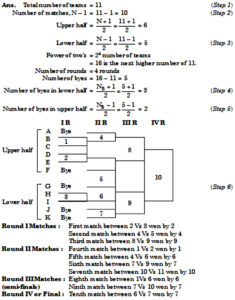 2. Draw a knockout fixture for 25 teams with all steps involved. (1.3) (CBSE 2020)
2. Draw a knockout fixture for 25 teams with all steps involved. (1.3) (CBSE 2020) 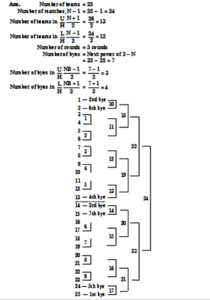 Seeding : Seeding is process in which strong teams/players are arranged in fixture in such a manner that they do not meet each other in the earlier round of the tournament. Seeding is such a method in which a strong team/players are selected to keep them at appropriate place in the fixture so that they do not meet in the earlier round. The organizer must be well aware regarding the previous performance of the selected team/player. Teams which are awarded seeding, will not play among themselves in the preliminary rounds. They will compete among themselves only in the later stage of the tournament. This helps to make the tournament very interesting as the suspense of good teams competing with each other is alive till the last. The teams which are seeded, may be the winner or runner up of last year’s tournament or may be high in performance ranking.
Seeding : Seeding is process in which strong teams/players are arranged in fixture in such a manner that they do not meet each other in the earlier round of the tournament. Seeding is such a method in which a strong team/players are selected to keep them at appropriate place in the fixture so that they do not meet in the earlier round. The organizer must be well aware regarding the previous performance of the selected team/player. Teams which are awarded seeding, will not play among themselves in the preliminary rounds. They will compete among themselves only in the later stage of the tournament. This helps to make the tournament very interesting as the suspense of good teams competing with each other is alive till the last. The teams which are seeded, may be the winner or runner up of last year’s tournament or may be high in performance ranking.
Remember : ——————————————————————- Procedure of allotting seeding is the same as given for byes. Allotment of seedings in the fixture should be given in following order : First seed will be given to last team of Lower Half, Second seed will be given to first team of Upper Half, Third seed will be given to first team of Lower Half, Fourth seed will be given to last team of Upper Half Same pattern will be followed after fourth seed till the remaining seeds have been given. ————————————————————————————–  Q. Mention all calculations and steps involved to draw a Knock-out fixture of 19 teams, where 4 teams are to be seeded. (1.3) (CBSE 2018, Delhi)
Q. Mention all calculations and steps involved to draw a Knock-out fixture of 19 teams, where 4 teams are to be seeded. (1.3) (CBSE 2018, Delhi) 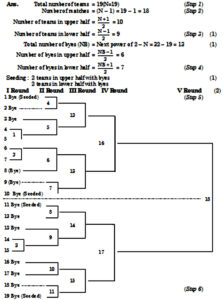 There is lucky team seeding method where team or a player is directly promoted to semi-finals Or quarter-finals without playing preliminary rounds of the tournament. Knock-out fixture for 26 teams (1, 2, 3, 4, 5, 6, 7, 8, 9, 10, 11, 12, 13, 14, 15, 16, 17, 18, 19, 20, 21, 22, 23, 24, 25, 26) giving Special Seeding to 1, 2, 3, 4 so that they start playing from quarterfinal
There is lucky team seeding method where team or a player is directly promoted to semi-finals Or quarter-finals without playing preliminary rounds of the tournament. Knock-out fixture for 26 teams (1, 2, 3, 4, 5, 6, 7, 8, 9, 10, 11, 12, 13, 14, 15, 16, 17, 18, 19, 20, 21, 22, 23, 24, 25, 26) giving Special Seeding to 1, 2, 3, 4 so that they start playing from quarterfinal 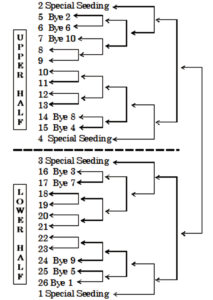
1.3.4 Procedure to Draw League or Round Robin Fixture
In a League or Round Robin Tournament, each team will play all of the remaining teams in the tournament once. Step 1 : Use the following formula to calculate the number of matches : Number of teams = n  This means that 10 matches will be played in the league tournament. For single league tournament there will be 36 matches but for double league tournament there will be 72 matches will be played. As explained to league tournament above. Step 2 : There are two methods for fixing a team in a league tournament: the Cyclic Method and the Stair Case Method.(It will be mentioned in question which method to apply) Staircase Method : In the Staircase Method, one team will be assigned to the highest step and will play with all of the tournament’s teams, and the next team will be assigned to the next lower step and will play with the remaining teams, and so on. Note : 8 columns are drawn vertically and horizontally to generate a fixture of 9 teams on a league basis using the staircase method. Then, as indicated in the picture above, the number assigned to each team or player is written in these columns. As we know in league tournaments each team play will every team in the tournament.
This means that 10 matches will be played in the league tournament. For single league tournament there will be 36 matches but for double league tournament there will be 72 matches will be played. As explained to league tournament above. Step 2 : There are two methods for fixing a team in a league tournament: the Cyclic Method and the Stair Case Method.(It will be mentioned in question which method to apply) Staircase Method : In the Staircase Method, one team will be assigned to the highest step and will play with all of the tournament’s teams, and the next team will be assigned to the next lower step and will play with the remaining teams, and so on. Note : 8 columns are drawn vertically and horizontally to generate a fixture of 9 teams on a league basis using the staircase method. Then, as indicated in the picture above, the number assigned to each team or player is written in these columns. As we know in league tournaments each team play will every team in the tournament.

1. Draw a fixture for 9 teams by round robin method. (1.3) (SQP 2019-20) 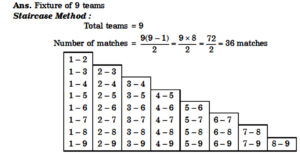 Cyclic Method : In the Cyclic Method, one team will be fixed in place while the other team will rotate clockwise to complete the cycle. This procedure may result in two situations: the first if the teams are even-numbered. Even number of teams in the tournament does not need giving byes to any team.Team number 1 is set on the top right hand side, while the other teams are rotated clockwise in increasing order sequentially downwards and upwards on the left side. The formula for calculating the number of rounds is number of teams 1. Number of Rounds = N – 1, N denotes number of teams 2. Draw a fixture of 6 teams on league basis following the cyclic method. (1.3) (CBSE 2016)
Cyclic Method : In the Cyclic Method, one team will be fixed in place while the other team will rotate clockwise to complete the cycle. This procedure may result in two situations: the first if the teams are even-numbered. Even number of teams in the tournament does not need giving byes to any team.Team number 1 is set on the top right hand side, while the other teams are rotated clockwise in increasing order sequentially downwards and upwards on the left side. The formula for calculating the number of rounds is number of teams 1. Number of Rounds = N – 1, N denotes number of teams 2. Draw a fixture of 6 teams on league basis following the cyclic method. (1.3) (CBSE 2016) 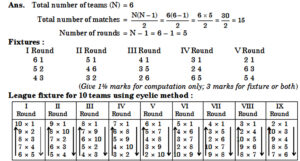
1, 2, 3, 4, 5, 6, 7, 8, 9 and 10 denotes name of the team
If the second if the teams are odd-numbered. To draw a fixture for an odd number of teams, one team will be given a bye in one round and another team will be given a bye in the next round. The tournament rounds will remain the same.Byes is now fixed on the top right side, and the rest of the procedure is the same as even numbers.Total number of teams is equal to Total number of rounds for odd number of teams. Total number of teams = 9; Total number of rounds = 9 3. Draw a fixture of nine (9) teams on the basis of league tournament using cyclic method. (CBSE 2019) 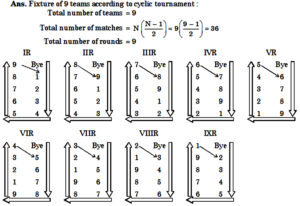 Step 3 : Declaring the winner/merit in League Tournament. The winner/merit of a League or Round Robin Tournament is determined by the points awarded to the teams. The following way is used to decide a winner: The team that win the match gets 2 points. The team that draw the match gets 1 point. The team that lose the match gets 0 point. After the tournament all the teams are awarded the score as per their performance and the team which scores maximum is declared winner. If the points are equal of two teams, then a match is held again between both the teams.
Step 3 : Declaring the winner/merit in League Tournament. The winner/merit of a League or Round Robin Tournament is determined by the points awarded to the teams. The following way is used to decide a winner: The team that win the match gets 2 points. The team that draw the match gets 1 point. The team that lose the match gets 0 point. After the tournament all the teams are awarded the score as per their performance and the team which scores maximum is declared winner. If the points are equal of two teams, then a match is held again between both the teams.
1.3.5 Procedure to Draw Combination Fixture
These tournaments are a combination of knockout and league tournaments. The same procedures will be followed as in Knockout and League matches. Procedure to draw Knockout-League fixtures : No. of teams = 16 For combination tournament teams are divided into four equal parts. 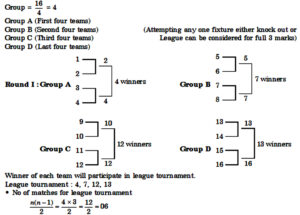 Fixture of league tournament by Staircase method : 4 – 7 4 – 12 7 – 12 4 – 13 7 – 13 12 – 13 Or Cyclic method : I II III 4 – 13 4 – 12 4 – 7 7 – 12 13 – 7 12 – 13 Procedure to draw League-Knockout fixtures : Total number of teams = 6; Total number of rounds = 6 – 1 = 5
Fixture of league tournament by Staircase method : 4 – 7 4 – 12 7 – 12 4 – 13 7 – 13 12 – 13 Or Cyclic method : I II III 4 – 13 4 – 12 4 – 7 7 – 12 13 – 7 12 – 13 Procedure to draw League-Knockout fixtures : Total number of teams = 6; Total number of rounds = 6 – 1 = 5 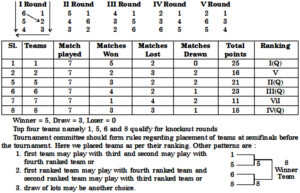 First semi-final match played between 1 vs 5 and won by 5 Second semi-final match played between 6 vs 8 and won by 8 Final match played between 5 vs 8 and won by 8 Third place match may be played between 1 vs 6 Team 8 winner of the League-Knockout tournament Team 5 is runner up of the tournament. Above data will change with changes in league table for operator
First semi-final match played between 1 vs 5 and won by 5 Second semi-final match played between 6 vs 8 and won by 8 Final match played between 5 vs 8 and won by 8 Third place match may be played between 1 vs 6 Team 8 winner of the League-Knockout tournament Team 5 is runner up of the tournament. Above data will change with changes in league table for operator
1.4 Intramural
1.4.1 Intramural Competition
Intra means inside the wall in Latin. Tournaments which are taking place inside the four walls of the school/institution i.e., inter-house and interclass competition are called as intramural competition. Members of the institute in which competition is conducted, can only participate. Intramurals are a widespread and vital element of educational organisations and communities, where teams are formed among classes, households, or groups and competitions are held to engage children and youth and provide various forms of rewards to participants. Objectives of intramural tournaments : (a) To promote mass participation : To provide opportunity to all the students to display their skills. (b) To develop socialization : Students can develop lots of social qualities like fair play, respect, friendship through sports. (c) To provide recreation : To focus on fitness, wellness and health aspects of children. (d) To hunt the talent : It provides first opportunity to the students to show their talent in a controlled environment. (e) To learn new skills : Provide opportunity to learn new skills. (f) To help children to develop personality and develop the feeling of sportsmanship. (g) To promote curricular integration through sports
1.4.2 Significance of Intramural Tournaments
I. Extramural Tournament Selection : Intramural Tournaments allow you to choose a player or team to compete in Extramural Tournaments. Players display ability and fitness in competitions that serve as the foundation for selecting a player or team. II. Group cohesion : This is an opportunity for students from various Classes or Houses to form a team, share their experiences, demonstrate cooperation and coordination, and lead the team to victory. Students from all origins and localities get together as a group to improve self-confidence, create social relationships, cultural tolerance, and so on. III. Professional experience : Based on the interests of the students and the needs of the institution, students assist in the organisation of the tournament, gaining valuable experience in officiating, event management, and so on. This experience will benefit them both professionally and personally in the future. IV. Health : It helps with the growth of a healthy and active lifestyle. Children appreciate sporting activities because it gives them another opportunity to demonstrate their desired skills. It aids in their fitness and health. Intramural sports contribute to children’s physical, mental, social, and spiritual well-being. V. Recreation : Intramural physical activities produce joy and enjoyment. Because activities are not very competitive, the elements of happiness and fun are always present, ensuring that intramural events are successful. VI. Mass participation : These events are intended for all of the school’s students, not only athletes or players. Advantages of intramural competition :
- Large number of students can participate.
- Talents can be spotted.
- It helps to develop leadership quality.
- It helps to provide recreations.
- It helps to provide opportunity to learn a variety of games and skills.
- It helps in providing an opportunity to get the experience of organizing a competition.
Disadvantage of intramural competition :
- Organization of the competition is not of high standard.
- Skill and performance of player is not of high standard.
- Level of competition is not of high standard.
1.4.3 Extramural Tournament
Extramural Competition : Extra means outside the wall in Latin. Tournaments which are taking place outside the four walls of the school i.e., between different schools, district, state, country are called as extramural. Members of different institutes can participate in the competition. The objectives of extramural competition :
- To encourage healthy lifestyle through participation in sports.
- To develop skills and techniques in a range of sporting activities.
- To encourage sportsmanship and to promote friendly relations among the schools.
- To raise the general standards of Sports and Games prevailing in the schools and to work for the all round development and values through sports amongst the students.
- To acquaint the students with the latest rules and regulations of sports and games.
- To provide a platform to compete with players high in sports talent and to test their emotional, mental and physical ability.
- To teach players to respect the game, officials, opponents, spectators and accept victory and defeat with grace.
- To give opportunity to develop skills in leadership.
Advantages of extramural competition :
- It helps to enhance the skill and performance to a high standard.
- Talents of players are tested.
- It helps to make implement programs of physical education more effectively in schools.
- It helps in enhancing the standard of sports technique.
- Organization of the competition is of high standard.
- It helps to provide appropriate knowledge of sports technique.
- It helps to provide experience to the student.
- It helps to develop sportsmanship and fraternity.
- It helps to get the knowledge of latest rules and regulations.
Disadvantage :
- Only a few players get an opportunity to participate.
- Competition place may be far from the school which may prevent the school from participating in the tournament.
- Cost of conducting the competition is high. So, every school may not be able conduct an extramural competition.
1.4.5 Significance of Extramural Tournaments
Performance improvement : Extramural competitions assist in raising performance levels by allowing athletes and sportspeople to gain experience, build tactical and strategic thinking skills, improve their physical fitness, and prepare psychologically, etc. Psychological factors : Extramural activities assist students develop skills like leadership and teamwork while balancing psychological aspects like stress, confidence, self-esteem, and emotions. Fitness level : An athlete’s level of fitness gradually rises as the difficulty of the competition rises, making them more physically and cognitively capable of competing at higher levels. Socialization : These competitions between various communities, regions, and nations encourage intercultural dialogue and community affiliation, giving people the chance to learn about and connect with other people from various backgrounds. Differences between Intramurals and Extramurals : 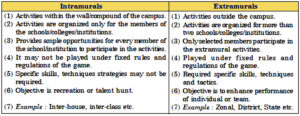
1.5 Community Sports : Purpose and Benefit
Community sports are a society-based method of providing people with chances to engage in sports, exercise, and fitness activities. The development of health promotion activities among community members, including schoolchildren, adults, seniors, and various other socially vulnerable populations, can be supported via community sports. Significance of Community Sports : I. Community sports are held for a wide range of objectives and involve members of the general public that live in a society. II. Community sports offer opportunity to hold sporting events on a regular basis for a variety of purposes such as community awareness initiatives, social campaigns, talent search, recreational activities, and so on. III. Community sports are frequently referred to be low-threshold sport activities, which make them an effective tool for engaging a diverse community in sports, exercise, and fitness behaviours. IV. Community sports are not necessarily competitive, and even when they are, they are not generally administered in a rule-book manner. V. For example, rather than professional officials, parents, experienced players, or other community volunteers may be involved in the organisation of sporting events.
1.5.1 Benefits of Community Sports
Health : Community sports programmes have a significant impact on an individual’s physical and emotional health. Regular physical activity not only improves cardiovascular and muscular health, but it also reduces the risk of a variety of lifestyle-related diseases. Social : Community Sports programmes offer a place for making friends, connecting people together and getting them to cooperate toward shared goals. Group cohesiveness, a proactive social environment, good citizenship, and other traits can be developed by creating a network of like-minded people. Psychological : Community sports programmes have been linked to better psycho-social health because they encourage ongoing, communal physical activity. They also offer a number of other psycho-social advantages, such as enhancing stress management, personal growth, and self-esteem. Economic : Regular community sports events will encourage resource efficiency and lessen the strain on the health budget. People who are healthy not only help to save medical costs but also improve national productivity by contributing the necessary amount of time and labour. Economically underprivileged groups might also benefit from taking part in such sports-related community programmes.
1.5.2 Community Sports
Sports Day : One of the significant events that appears on the annual calendar of the majority of residential areas and community schools is Sports Day. Importance of sports day : I. It’s a chance for the community to meet, greet, and connect with one another in addition to showcasing the skills and ability of children and youth on the sports field. II. It also shows how well-organized the society’s members and other organising entities are. III. The goal of celebrating Sports Day should be to showcase a wide range of skills among its participants, not just the participation of outstanding athletes. IV. Maximum participation and engagement of community members and other stakeholders should be a major priority. Important Facts : ———————————————————— Government of India is celebrating National Sports Day on 29th August on the occasion of birth anniversary of Major Dhyan Chand, a hockey legend. ————————————————————————————- Health Run : Health Run is a typically held to improve health standards in society and raise awareness about the benefits of physical activity in sustaining good health or to raise funds for charity. Need of Health Run :
- The runners’ goal in this race is not to win, but to participate in the events.
- A significant number of registrations are necessary to maximise its impact.
- There is no age restriction for participants, and because this is not a professional event, there is no need to run a big distance.
- NGOs or health departments can organise such a run to raise awareness about health issues.
Steps to organise a Health Run in your school :
- Constitute/Institute various committees with HOS/Principal as organizing head of the event.
- HOD physical Education will be responsible for the entire programme.
- Wide publicity to be given regarding the event to all the stake holders of the school.
- Since it will not be competition, students of all age, parents and staff will be eligible to participate in the run.
- Marking the course of the run.
- Local govt. and civic authorities to be informed for permission.
- Police to be informed for security purposes.
- Have first aid and water facilities in the venue.
- Arrange for incentives and certificates to all participants.
Leadership qualities to conduct Physical Activity by you :
- Energetic : It is the basic requirement to participate in any physical activity. It is necessary for a leader to be energetic in the field.
- Intelligent : Intelligence is the ability of an individual to find out the possible solution of various complex problems.
- Creative : A leader should be creative. A creative leader can produce new techniques, ideas which are needed in the field.
- Decisiveness : A leader should be decisive. He should have the ability of taking decisions spontaneously.
Run for Fun :
- The goal of this run is to spread the message of remaining fit and healthy to the general public.
- Such races are sometimes held to raise donations for a specific cause.
- Such races draw children and their parents to schools.
- These are friendly races that can be held for any age group.
- However, the physical education instructor must be cautious and attentive in order to avoid any form of incident or accident.
- Age, mobility, and the sorts of movement required should all be considered.
- Lemon and spoon races, sack races, three-legged races, parent and child races, teacher and kid races, banana races, road running, and so on are examples of such races.
Run for Specific Cause :
- This event is typically held to raise awareness about social issues such as sanitation and the promotion of a green environment.
- The goal of such gatherings is to raise public awareness about a specific cause or to earn charitable donations.
- For example, the precise reason could be cancer, AIDS, or gender inequity.
Run for Unity :
- The goal of such a run is to develop a sense of integrity and brotherhood in a community, state, nation, or among different religions.
- Such gatherings promote connection and a sense of community among participants.
Games and Sports :
- Sports competitions and other games can be planned with the community’s overall growth in mind.
- To maintain people aware with the country’s cultural past, indigenous games like kho-kho, kabaddi, marbles, Gillidanda, etc., may be introduced.
